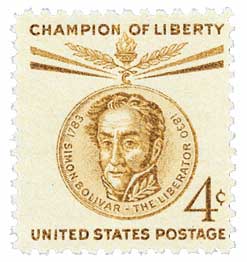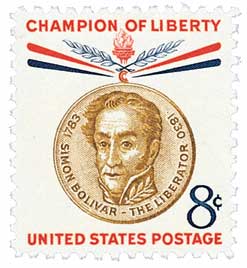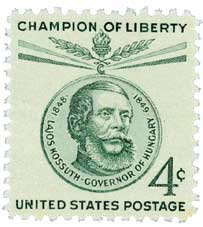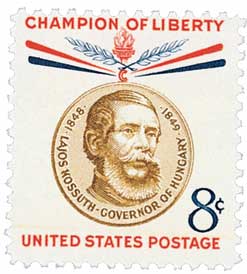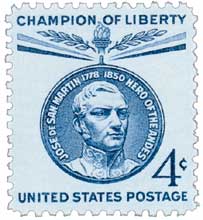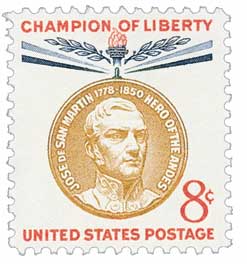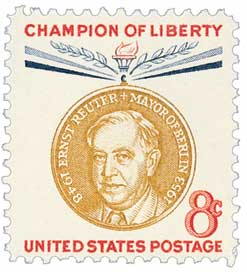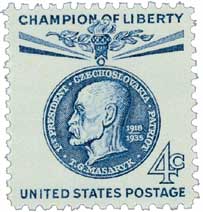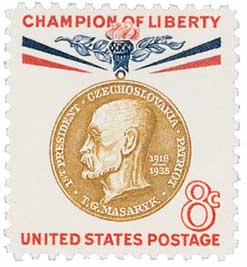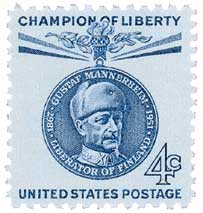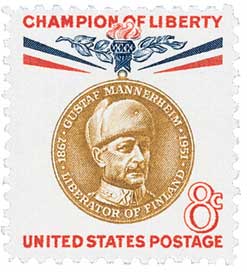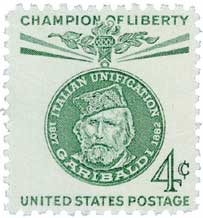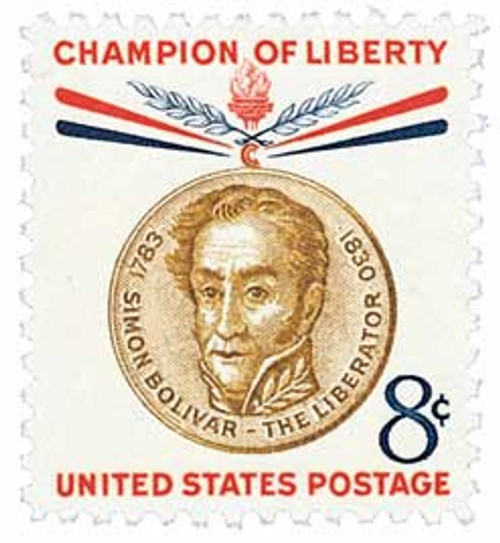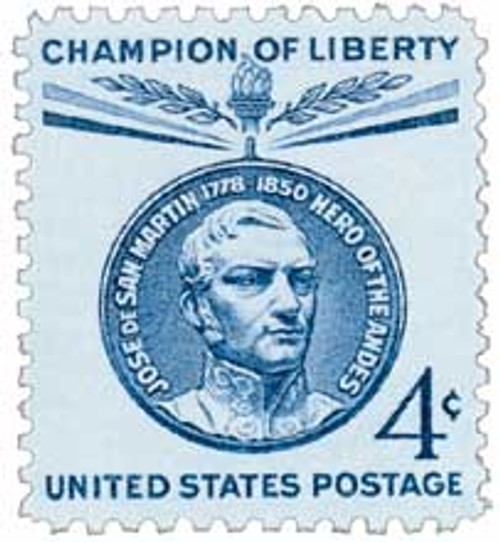
# 1165 FDC - 1960 4c Champions of Liberty: Gustaf Mannerheim
4¢ Gustaf Mannerheim
Champions of Liberty Series
City: Washington, D.C.
Quantity: 124,796,000
Printed by: Bureau of Engraving and Printing
Printing Method: Rotary Press
Perforations: 10 1/2 x 11
Color: Blue
Champion Of Liberty Series
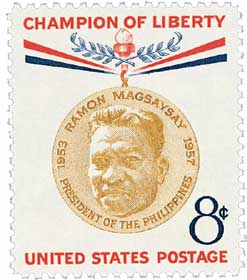
On August 31, 1957, the US Post Office issued an 8¢ stamp honoring Ramon Magsaysay, the first stamp in a new Champion of Liberty Series.
The stamp was issued just five months after Magsaysay, the seventh President of the Philippines, had died in a plane crash. Magsaysay’s administration was noted for its freedom from corruption. Under his direction, the Philippines joined the Southeast Asia Treaty Organization. The Magsaysay stamp was issued on his birthday and was the largest US postage stamp issued up to that time.
That stamp would be the first in a new series, dubbed “Champion of Liberty.” As America was embroiled in the Cold War, the Eisenhower administration saw these stamps as a way to combat Soviet totalitarianism by honoring men who fought for freedom in their homelands. Each of the people honored in the Champions of Liberty series struggled courageously to protect their homeland from tyranny and further the cause of freedom.

After Magsaysay’s single commemorative stamp was issued, the rest of the series had two stamps printed for each subject – one in a single color, and one with three colors. The pairs were also of different denominations. The single color stamps covered the domestic rate, while the multi-color stamps paid the international rate, to “carry the message of freedom around the world.”
Simón Bolívar, was nicknamed the “George Washington of South America.” For over 20 years, Bolívar worked tirelessly to liberate its lands. Through a series of battles, Bolívar invaded and took over Merida, Caracas, and Venezuela, at which point he was proclaimed El Libertador.
Lajos Kossuth, a Hungarian revolutionary, fought tirelessly for independence for Hungary, and served briefly as Governor-President when the country earned its independence in 1849. But in 1851, the government collapsed as the area was taken over by Austria, and Lajos moved to America. His popularity was so great that it caused tensions between the United States and Austria, who wanted him given into their custody.
José de San Martín was one of the key figures in the Spanish-American Revolutions in the early 1800s. San Martín is considered the greatest of the Libertadores of South America, along with Símon Bolívar. He led the campaigns that liberated Argentine, Chile, and Peru.
Ernst Reuter was the mayor of West Berlin during the early years of the Cold War. As the Soviets tried to block access to West Berlin, Reuter became the spokesman for the West Berlin citizens, appealing to the world before a crowd of 300,000 to not abandon Berlin. In response, the Allies coordinated the “Berlin Airlift,” a massive effort of over 200,000 flights to provide supplies.
Thomas Masaryk was born in Austria-Hungary, and later became the founder and first president of the Czechoslovakia Republic. Masaryk was a member of the Austrian parliament, and tried to reform the Hapsburg Empire into a democratic state. After the Austria-Hungary Empire was dissolved following World War I, Masaryk was named head of the Provisional Government. He was elected first President of the Czechoslovak Republic in November 1918.
Born in Poland, Ignacy Paderewski was arguably the finest musician of his era, and also famed for his wit. Paderewski frequently performed before huge crowds in the US and championed Poland’s independence. He later served as its third Prime Minister.
Born in the Grand Duchy of Finland, Carl Gustaf Emil Mannerheim rose to the rank of general in the Russian army. When Finland was at war with the Soviet Union between 1939 and 1944, Mannerheim became commander of Finland’s armed forces. He later served as Marshal and President of Finland.
4¢ Gustaf Mannerheim
Champions of Liberty Series
City: Washington, D.C.
Quantity: 124,796,000
Printed by: Bureau of Engraving and Printing
Printing Method: Rotary Press
Perforations: 10 1/2 x 11
Color: Blue
Champion Of Liberty Series

On August 31, 1957, the US Post Office issued an 8¢ stamp honoring Ramon Magsaysay, the first stamp in a new Champion of Liberty Series.
The stamp was issued just five months after Magsaysay, the seventh President of the Philippines, had died in a plane crash. Magsaysay’s administration was noted for its freedom from corruption. Under his direction, the Philippines joined the Southeast Asia Treaty Organization. The Magsaysay stamp was issued on his birthday and was the largest US postage stamp issued up to that time.
That stamp would be the first in a new series, dubbed “Champion of Liberty.” As America was embroiled in the Cold War, the Eisenhower administration saw these stamps as a way to combat Soviet totalitarianism by honoring men who fought for freedom in their homelands. Each of the people honored in the Champions of Liberty series struggled courageously to protect their homeland from tyranny and further the cause of freedom.

After Magsaysay’s single commemorative stamp was issued, the rest of the series had two stamps printed for each subject – one in a single color, and one with three colors. The pairs were also of different denominations. The single color stamps covered the domestic rate, while the multi-color stamps paid the international rate, to “carry the message of freedom around the world.”
Simón Bolívar, was nicknamed the “George Washington of South America.” For over 20 years, Bolívar worked tirelessly to liberate its lands. Through a series of battles, Bolívar invaded and took over Merida, Caracas, and Venezuela, at which point he was proclaimed El Libertador.
Lajos Kossuth, a Hungarian revolutionary, fought tirelessly for independence for Hungary, and served briefly as Governor-President when the country earned its independence in 1849. But in 1851, the government collapsed as the area was taken over by Austria, and Lajos moved to America. His popularity was so great that it caused tensions between the United States and Austria, who wanted him given into their custody.
José de San Martín was one of the key figures in the Spanish-American Revolutions in the early 1800s. San Martín is considered the greatest of the Libertadores of South America, along with Símon Bolívar. He led the campaigns that liberated Argentine, Chile, and Peru.
Ernst Reuter was the mayor of West Berlin during the early years of the Cold War. As the Soviets tried to block access to West Berlin, Reuter became the spokesman for the West Berlin citizens, appealing to the world before a crowd of 300,000 to not abandon Berlin. In response, the Allies coordinated the “Berlin Airlift,” a massive effort of over 200,000 flights to provide supplies.
Thomas Masaryk was born in Austria-Hungary, and later became the founder and first president of the Czechoslovakia Republic. Masaryk was a member of the Austrian parliament, and tried to reform the Hapsburg Empire into a democratic state. After the Austria-Hungary Empire was dissolved following World War I, Masaryk was named head of the Provisional Government. He was elected first President of the Czechoslovak Republic in November 1918.
Born in Poland, Ignacy Paderewski was arguably the finest musician of his era, and also famed for his wit. Paderewski frequently performed before huge crowds in the US and championed Poland’s independence. He later served as its third Prime Minister.
Born in the Grand Duchy of Finland, Carl Gustaf Emil Mannerheim rose to the rank of general in the Russian army. When Finland was at war with the Soviet Union between 1939 and 1944, Mannerheim became commander of Finland’s armed forces. He later served as Marshal and President of Finland.






